In the realm of fitness and combat sports, the punching bag stands as a timeless tool, evolving continuously to meet the ever-changing demands of training and exercise regimes. As 2024 approaches, this market segment is not only expanding but also diversifying, offering a plethora of options designed to enhance strength, endurance, and technique for users at various levels. From robust, heavy bags capable of taking the hardest hits to technologically advanced models that offer detailed feedback, the current landscape presents a rich array of choices. This variety ensures that entities engaged in the procurement of fitness equipment can find the right fit to cater to the specific needs of their clientele, ensuring a blend of quality, innovation, and user satisfaction.
Table of Contents
1. Punching bag varieties and applications
2. Market insights andtrends
3. Criteria for product selection
4. Leading punching bagmodels of 2024
5. Conclusion
Punching bag varieties and applications

In the expansive landscape of fitness and combat training, understanding the diverse punching bag types and their specific applications is crucial for equipping fitness facilities with the right tools. This section explores the different types of punching bags and how each serves distinct training scenarios.
Different types of punching bags
The world of punching bags is vast, with each type designed to fulfill a unique aspect of training. Traditional heavy bags, weighing up to 200 pounds, are the stalwarts of strength and endurance training. Used in a myriad of combat sports like boxing, kickboxing, and Muay Thai, these bags are typically suspended from the ceiling or a sturdy stand, offering a dynamic target that swings back with each hit, simulating a real fight scenario.
Freestanding punching bags are another popular choice, offering the advantage of portability and ease of installation. These bags come attached to heavy bases filled with sand or water, providing stability without the need for permanent mounting. They are ideal for spaces where hanging a heavy bag is impractical and are particularly favored for practicing a variety of kicking techniques.
Speed bags, significantly smaller and filled with air, are indispensable in training for speed, timing, and rhythm. These teardrop-shaped bags, often mounted from ceilings or walls, bounce back quickly upon being struck, helping athletes enhance their punching speed, develop hand-eye coordination, and build cardiovascular endurance.
Usage scenarios for various bag types
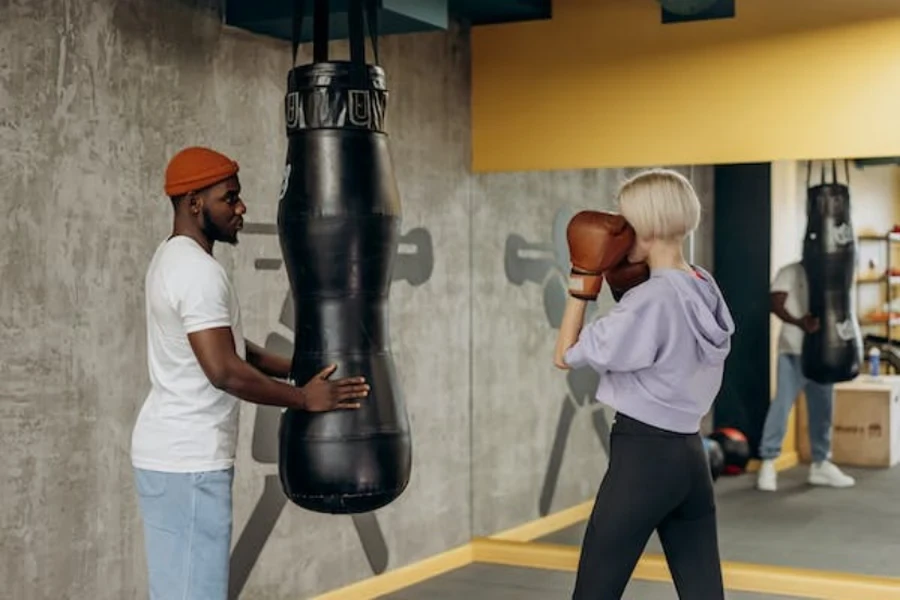
Heavy bags are synonymous with building brute strength and power. They are the go-to for athletes looking to enhance their punching and kicking force, making them a mainstay in gyms focusing on boxing, martial arts, and intense cardio workouts. A 200-pound person, for instance, might find a 100-pound heavy bag ideal, while someone lighter might opt for a 40 to 70-pound bag.
Freestanding bags shine in versatility and ease of use, suited for various martial arts and general fitness routines. They are especially beneficial in living spaces or areas where wall installations are limited. However, their mobility might sometimes be a drawback, as vigorous sessions could cause them to tip over. Innovations like the FightCamp free-standing bag, designed with a bag ring to prevent this issue, signify the advancements in this area.
Speed bags, due to their compact size and fast rebound, are excellent for honing punching accuracy and speed. They’re a fixture in traditional boxing training, where quick, repetitive strikes are essential. These bags typically require a permanent installation, ensuring they can withstand the rapid, consistent hits they’re designed for.
Each punching bag type caters to different facets of training, from raw power and endurance to speed and precision. Selecting the right type hinges on understanding the specific training needs of the users and the logistical aspects of the training space. By providing a variety of bags, facilities can offer comprehensive training tools that cater to a wide range of preferences and objectives, ensuring a well-rounded fitness experience.
Market insights and trends
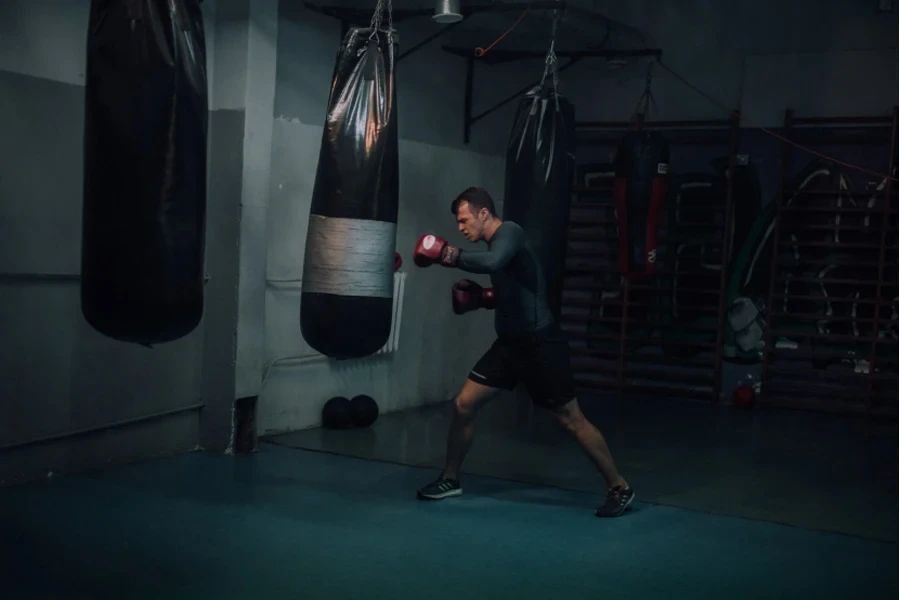
In the intricate tapestry of market dynamics, the punching bag sector stands as a testament to continual evolution, shaped by a confluence of factors influencing consumer behavior and pricing. As entities explore this market, an understanding of its size, growth drivers, and shifting consumer preferences is paramount.
Current market dynamics
The punching bag market is a subset of the broader fitness and combat sports industry, exhibiting steady growth propelled by an increasing focus on health and wellness. Experts currently value the punching bag market at USD 57.0 million as of 2023 and anticipate it reaching USD 88.92 million by 2030. They estimate this boost will happen at a 7.69% compound annual growth rate (CAGR) from 2023 to 2030. Consumer demand is significantly influenced by the availability and quality of products, with preferences tending towards items offering durability, versatility, and technological integration. These preferences guide the pricing and availability of various punching bag types, with consumers showing a willingness to invest in higher-quality items that promise a longer lifespan and enhanced training experience.
The market is also shaped by supply-side factors, with manufacturers and suppliers constantly innovating to meet the rising standards of quality and functionality demanded by consumers. This innovation is not just in the product itself but also in the way it’s delivered, with online retail platforms becoming a crucial part of the supply chain, offering wider accessibility and convenience.
Emerging trends in punching bag usage
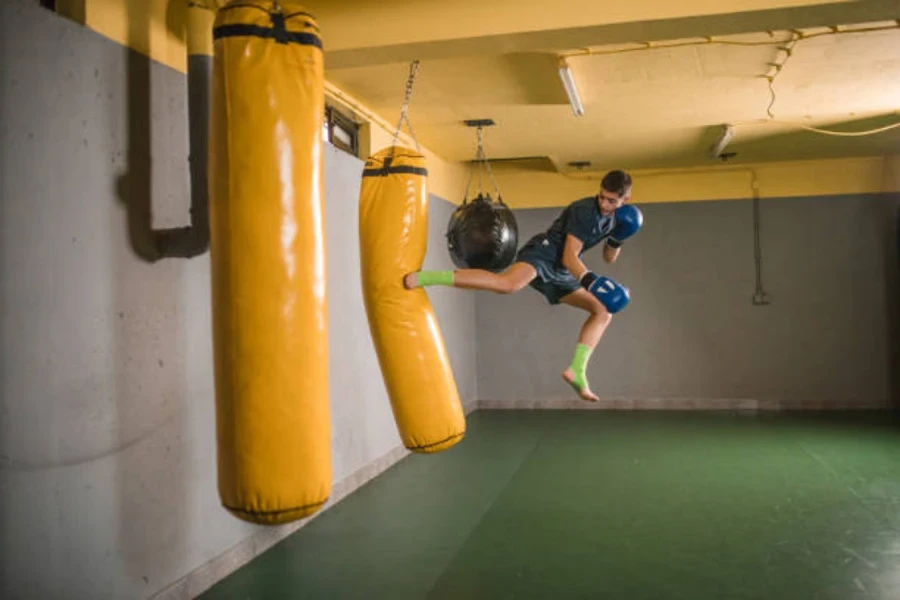
The landscape of punching bag usage is undergoing significant transformation, driven by emerging fitness trends and changing consumer lifestyles. There’s a notable shift towards more personalized and home-based training regimes, spurred by global events that have reshaped how individuals approach fitness. This shift has led to a surge in demand for home gym equipment, with punching bags being a popular choice for their multifaceted benefits and ease of use.
Technological advancements are another trend shaping the punching bag market. Modern consumers seek products that offer more than just physical robustness; they want interactive training experiences. This demand has given rise to smart punching bags equipped with sensors and connectivity features, allowing users to track their performance, access online training modules, and integrate their workouts with other fitness platforms.
Moreover, there’s a growing emphasis on products catering to a broader range of skill levels, from beginners to professional athletes. This trend is leading to the diversification of product offerings, with bags designed for specific training needs, such as speed, precision, or strength.
These emerging trends reflect a dynamic market, responsive to the changing needs and preferences of consumers. For entities involved in product procurement and retail, staying abreast of these trends is crucial for aligning their offerings with market demand, ensuring they provide products that resonate with the evolving needs of fitness enthusiasts and professionals alike.
Criteria for product selection
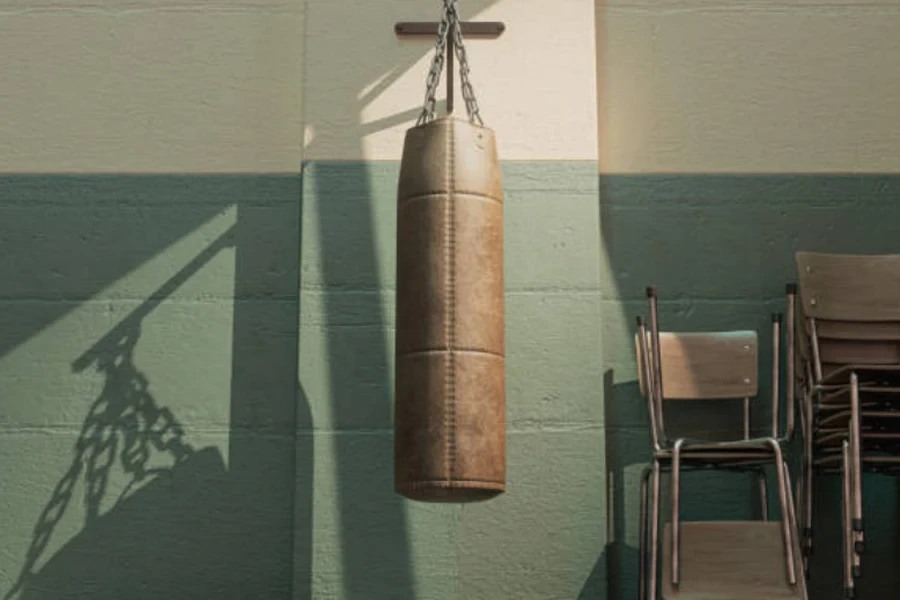
In the realm of fitness equipment, particularly punching bags, the criteria for selecting the right product are paramount. These criteria ensure that the end user, whether a novice or a professional, has a tool that meets their specific training needs.
Material and durability considerations
The material used inside and outside a punching bag greatly influences its durability and the type of training it can support. Shredded textiles are a popular choice for fillings, made from discarded clothing or fabric scraps, providing a forgiving surface that helps distribute the impact of punches and kicks. This material is not only cost-effective but allows for easy customization in terms of density, though it may require occasional readjustment as the material settles over time.
For a denser and heavier feel, some opt for sand. It offers greater resistance, making it ideal for power and endurance training. However, it’s crucial to ensure proper encasement to avoid the risk of injury due to its unforgiving nature when overly filled or improperly encased. The drawback is that it can be more expensive and less easy to adjust than other materials.
Water-filled bags have surged in popularity, offering a dynamic resistance that mimics the movement of a human body, making them especially beneficial for martial arts. They provide a realistic feel and are adjustable by adding or removing water, but they require careful maintenance to avoid leaks.
Synthetic fiber fills, such as high-density foam or polyester fibers, are alternatives offering consistent density and durability. They maintain their shape well and provide good shock absorption, minimizing the risk of injury, but tend to be more expensive.
Rice, grain, or beans are traditional fillings used in certain martial arts practices, offering unique texture and weight distribution. While providing a distinct training experience, these require vigilant handling and regular inspection to ensure the contents remain uncompromised.
Size and weight specifications
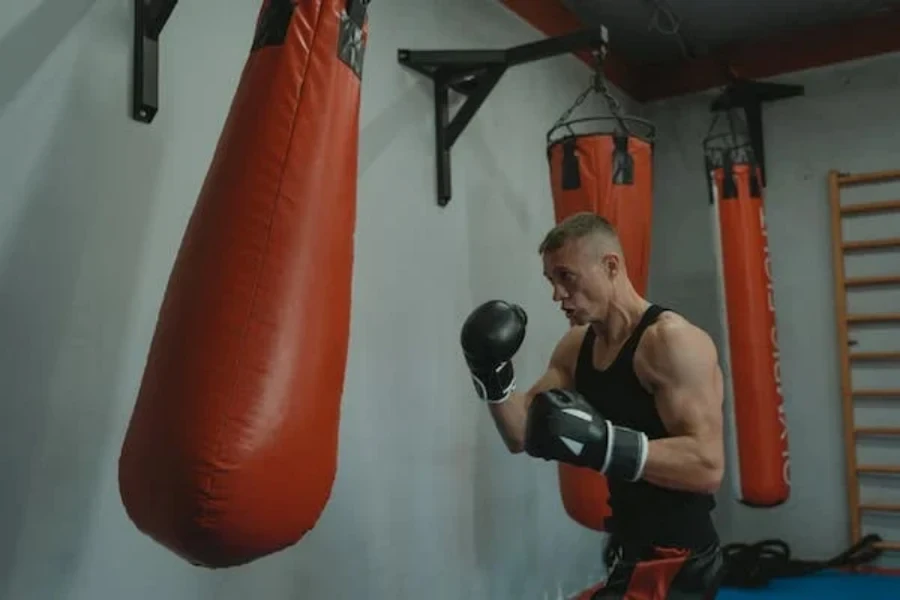
Size and weight are pivotal factors that dictate the suitability and efficacy of a punching bag for various training needs. As such, a deeper understanding of these specifications helps in making informed choices.
The size of a punching bag, typically measured in height and diameter, directly influences the type of training it can support. For instance, longer bags, ranging from 4 to 5 feet, are preferred for kickboxing or Muay Thai, as they allow practitioners to work on low kicks and knee strikes. In contrast, shorter bags, around 2.5 to 3 feet, are ideal for boxing, focusing more on hand strikes and upper body techniques.
The weight of the bag is equally crucial. A common guideline is that a bag should weigh about half the user’s weight to provide sufficient resistance without excessive swaying. For example, a 150-pound individual might opt for a 70 to 80-pound bag for a balanced training experience. However, for those focusing on building power and strength, heavier bags, perhaps two-thirds of their weight, might be more appropriate as they provide more resistance and less movement, simulating a more stable target.
The distribution of weight within the bag also matters. Consistent, even filling prevents hard spots and ensures the bag reacts predictably with each strike, an essential factor for those refining their technique. Modern bags often come with internal compartments or layers, allowing for more uniform weight distribution and minimizing the risk of settling and hardening of fill materials over time.
Modern punching bags have evolved to include features that address the specific needs of various training routines. Adjustable-height bags are now common, catering to users of different heights and allowing for a more tailored training experience. Some bags even come with adjustable bases, letting users alter the bag’s stability to simulate different opponents or training scenarios.
In terms of weight adjustability, water-filled bags have become popular for their ability to easily increase or decrease weight. By simply adding or removing water, users can customize the bag’s weight to their current training level, a feature especially beneficial for those gradually building strength or for facilities catering to a wide range of users.
Moreover, some bags are designed for easy relocation, featuring lightweight materials and portable designs. These are particularly beneficial for home gyms or multipurpose training spaces where the bag needs to be moved or stored after use.
In selecting a punching bag, understanding these size and weight specifications and how they relate to training needs is key. Whether it’s the length of the bag for practicing low kicks or the weight for developing powerful strikes, each aspect contributes to a more effective and tailored training experience. As such, these considerations are integral in ensuring that the selected bag meets the specific requirements of the users, ultimately leading to a more productive and satisfying workout.
Advanced features and technologies
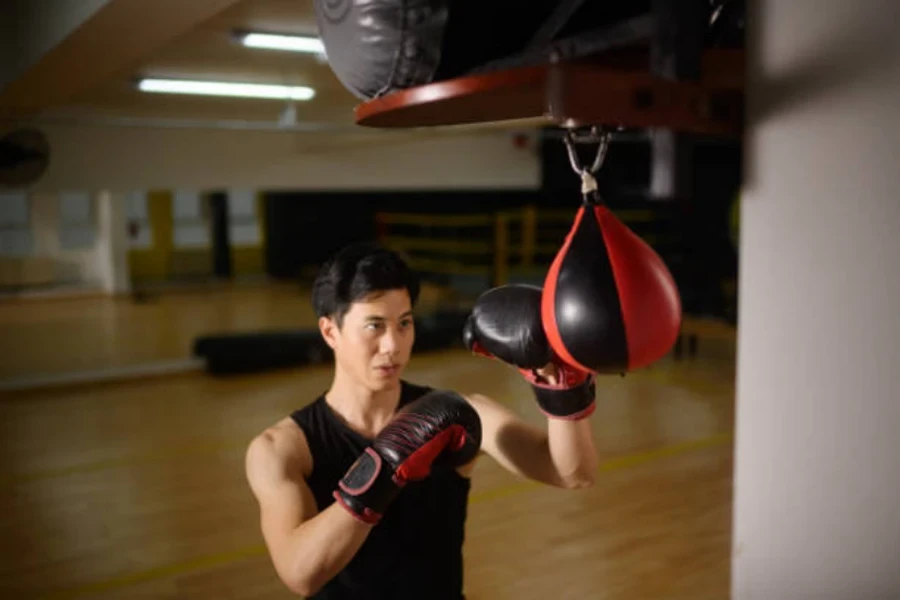
Modern punching bags aren’t just about material and weight; they also incorporate advanced technologies and features to enhance the training experience. Many now come with adjustable resistance settings, allowing users to tailor the bag’s response to their training level and goals. Electronic scoreboards and connectivity to training apps are also becoming standard, offering users real-time feedback on their performance, including the number of strikes, force exerted, and calories burned.
Some high-end models also feature interactive training programs with virtual trainers, guiding users through workouts and providing tips to improve form and technique. These bags may also have sensors that detect and record the accuracy and intensity of strikes, providing detailed feedback that can be used to track progress over time.
In terms of setup and convenience, many modern bags are designed for easy installation and portability. Features like quick-setup stands, or the ability to deflate and store the bag, make it suitable for transient spaces or home gyms where space is at a premium.
In conclusion, when selecting a punching bag, it’s crucial to consider the material and durability, size and weight specifications, and any advanced features that can enhance the training experience. These criteria ensure that the product not only meets the training needs of the user but also offers durability and quality, reflecting well on the providers and retailers who supply them.
Leading punching bag models of 2024
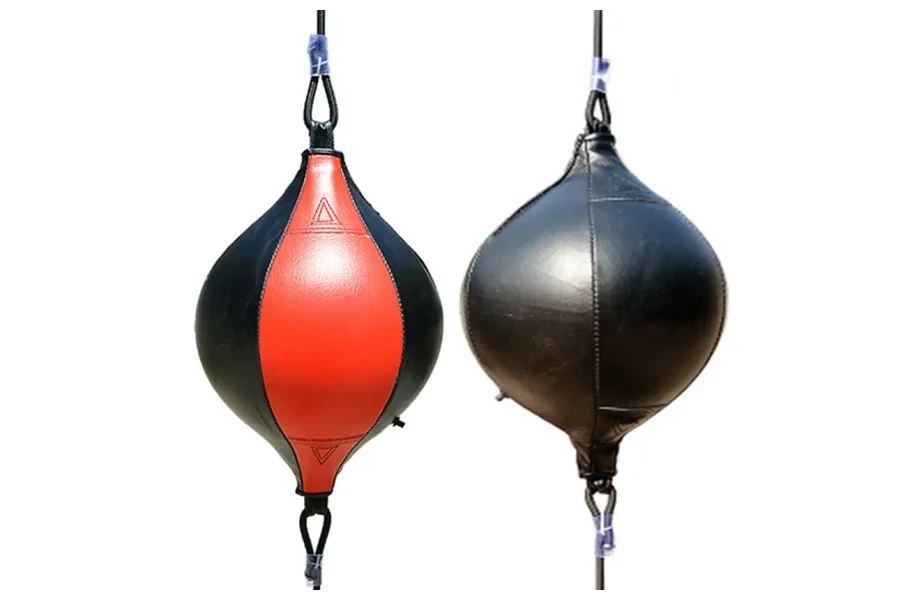
As 2024 unfolds, the market for punching bags is replete with advanced models designed to meet the diverse training needs of individuals. This section will explore some of the leading models in heavy bags, freestanding, and speed bag categories, along with a comparative analysis based on their features, performance, and user feedback.
Top picks for heavy bags
When it comes to selecting heavy punching bags for 2024, four models stand out for their exceptional features and quality, making them top choices in the market.

Everlast’s Single Station Heavy Bag Kit: This all-in-one set is designed to accommodate users of all experience levels. The kit includes a 70-pound heavy bag, gloves, and hand wraps, making it ready for use right out of the box. The stand requires some assembly, but its sturdy construction and ability to add weight plates for increased stability make it an excellent choice for intense workouts. The bag’s material and filling provide a balanced density, suitable for beginners yet resilient enough for more advanced training.
FITVEN Freestanding Punching Bag: The FITVEN model is notable for its versatility and ease of assembly. It features a 205-pound freestanding bag with 360-degree usability, ideal for dynamic workouts. The base, which can be filled with sand or water, is equipped with suction cups to enhance stability during use. This model’s synthetic leather and foam composition strike a perfect balance between softness for comfort and firmness for effective training.
Outslayer 100-Pound Punching Bag: The Outslayer bag is a heavy-duty option, weighing 100 pounds and measuring 55 inches in length. It is fabric-filled, which prevents the formation of hard or hollow spots common in sand-filled bags. This bag is designed with heavy-duty straps instead of chains for quieter operation and is known for its durability. Its density is more suited to advanced users, but the filling can be adjusted for customization.
Combat Sports Muay Thai 100-Pound Heavy Bag: Specifically designed for Muay Thai practitioners, this bag is 72 inches long, allowing for a full range of strikes, including low kicks. Made from tough synthetic leather, it’s both sturdy and easy to clean. The bag comes pre-filled to 100 pounds, providing a dense and heavy platform ideal for powerful kicks and punches. Its extra length and durability make it an excellent choice for those focusing on both punches and kicks.
Each of these models has been rigorously tested for ease of use, effectiveness, comfort, durability, and value, ensuring they meet the diverse needs of users in 2024. From the all-inclusive Everlast kit to the specialized Combat Sports Muay Thai bag, these top picks cater to a wide range of training preferences and skill levels. Their robust construction and thoughtful design elements place them at the forefront of the heavy punching bag market.
Best freestanding and speed bag options
In the realm of punching bag options for 2024, both freestanding and speed bags continue to evolve, providing sophisticated features tailored to varied training needs. Here’s a closer look at two top real-world models for each category.

Freestanding bags:
Century Wavemaster XXL Training Bag: The Century Wavemaster XXL stands out for its remarkable durability and stability. With a striking surface made from high-quality vinyl and a dense foam filling, this bag can withstand the most intense training sessions. It’s approximately 69 inches tall and 18 inches in diameter, offering a substantial surface area for various strikes. The low-profile base can be filled with either sand or water, weighing up to 270 pounds when filled, ensuring it remains stable even under the most powerful impacts. Its ease of assembly and portability make it a popular choice for those needing a versatile and reliable freestanding bag.
PowerCore Free Standing Heavy Bag by Everlast: The PowerCore Free Standing Heavy Bag is renowned for its innovative features. The PowerCore steel plate technology improves overall strength, while the shock-absorbing foam is encased in a durable Nevatear outer layer, ensuring long-lasting use and comfort. The bag’s height is adjustable, ranging from 54 to 65 inches, accommodating users of different sizes. Its rounded base allows for easy relocation, making it an ideal choice for versatile training spaces. The bag’s design focuses on improving striking power and speed, catering especially to those looking to enhance their boxing or martial arts skills.
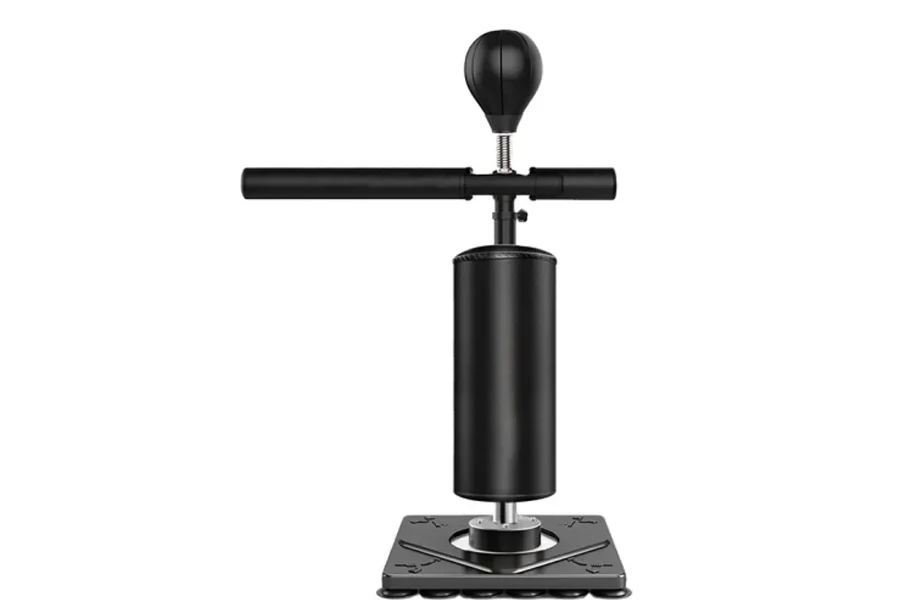
Speed bags:
Cleto Reyes Platform Speed Bag: The Cleto Reyes Platform Speed Bag is a top choice for professionals and enthusiasts alike. Made from high-quality genuine leather, it’s designed for rapid rebounds and long-term durability. The bag’s balanced design ensures consistent performance, essential for developing rhythm and hand-eye coordination. Its traditional teardrop shape helps to improve accuracy and timing, making it an excellent tool for refining boxing techniques. The Cleto Reyes Speed Bag is available in various sizes, allowing users to select the one that best fits their skill level and training preferences.
Title Boxing Gyro Balanced Speed Bag: The Gyro Balanced Speed Bag from Title Boxing is crafted to provide superior balance and faster rebounds. It’s constructed from top-grade leather with reinforced seams, ensuring it can withstand the rigors of frequent use. The gyro-balanced design ensures efficient and consistent performance, essential for building speed and precision. This bag is favored by those looking to enhance their reflexes and coordination, with its reliable performance making it a staple in many training regimens. Available in multiple sizes, it caters to a wide range of users, from beginners to seasoned professionals.
Each of these models brings unique features and design elements to the table, reflecting the ongoing innovation in the punching bag market. Whether it’s the stability and versatility of freestanding bags or the precision and speed of the speed bags, these top picks for 2024 are sure to meet the diverse needs of users, enhancing their training experience and performance.
Comparative analysis of model specifications
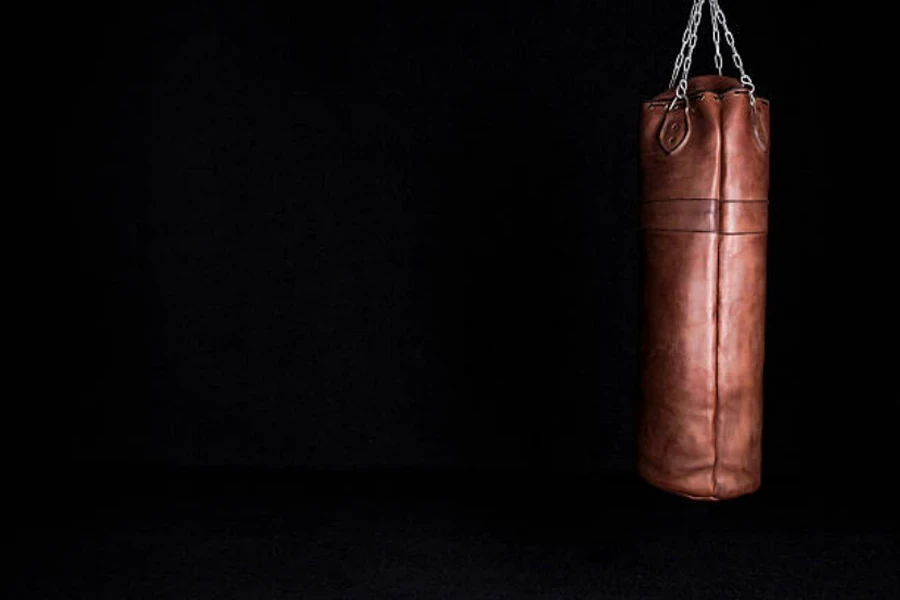
A comparative analysis of the model specifications of the eight punching bags discussed in the previous sections helps discern the best options based on distinct features or usage scenarios. Here’s a breakdown focusing on durability, material quality, user experience, and specific training suitability.
Durability:
Heavy Bags: The Outslayer 100-Pound Punching Bag and Combat Sports Muay Thai 100-Pound Heavy Bag are renowned for their durability. The Outslayer boasts a 10-year warranty, reflecting its long-lasting build. The Combat Sports model, with its sturdy synthetic leather, is also known for enduring rigorous training sessions.
Freestanding Bags: Century Wavemaster XXL’s high-density foam and durable vinyl cover make it highly resistant to wear and tear. Meanwhile, Everlast’s PowerCore incorporates steel plate technology, providing a robust structure that withstands powerful strikes.
Speed Bags: Cleto Reyes’s genuine leather construction is synonymous with durability, often outlasting its competitors. Title Boxing’s Gyro Balanced Speed Bag, with its reinforced seams and top-grade leather, is also built to last, even under frequent and fast-paced use.
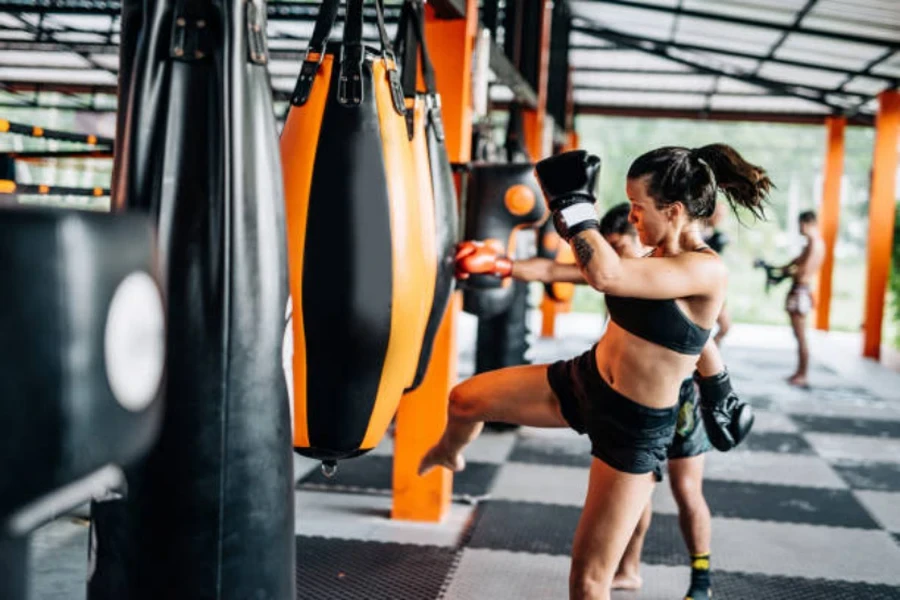
Material quality:
Heavy Bags: Everlast’s Single Station Heavy Bag Kit uses high-grade leather, ensuring a premium feel and longer life. Outslayer’s fabric filling prevents hard spots and provides a consistent striking experience.
Freestanding Bags: The PowerCore Free Standing Heavy Bag’s Nevatear outer layer offers durability and a professional look, while Century Wavemaster XXL’s vinyl cover is known for its resilience and easy maintenance.
Speed Bags: Both the Cleto Reyes Platform Speed Bag and Title Boxing Gyro Balanced Speed Bag are made from genuine leather, providing a smooth, durable surface that withstands rapid strikes and maintains shape over time.
User experience:
Heavy Bags: The Everlast Single Station provides an all-in-one setup with gloves and wraps included, ideal for beginners. In contrast, the Combat Sports Muay Thai bag’s extra length offers a varied striking surface, preferred by advanced users for comprehensive training.
Freestanding Bags: Century Wavemaster XXL is appreciated for its stability and large striking surface, making it user-friendly for both beginners and pros. Everlast’s PowerCore is lauded for its adjustable height and easy relocation, offering a personalized and flexible training experience.
Speed Bags: The Cleto Reyes bag’s consistent rebound and professional quality are favored by advanced users, while Title Boxing’s Gyro Balanced bag is praised for its balanced, predictable performance, suitable for users at all levels looking to improve speed and coordination.
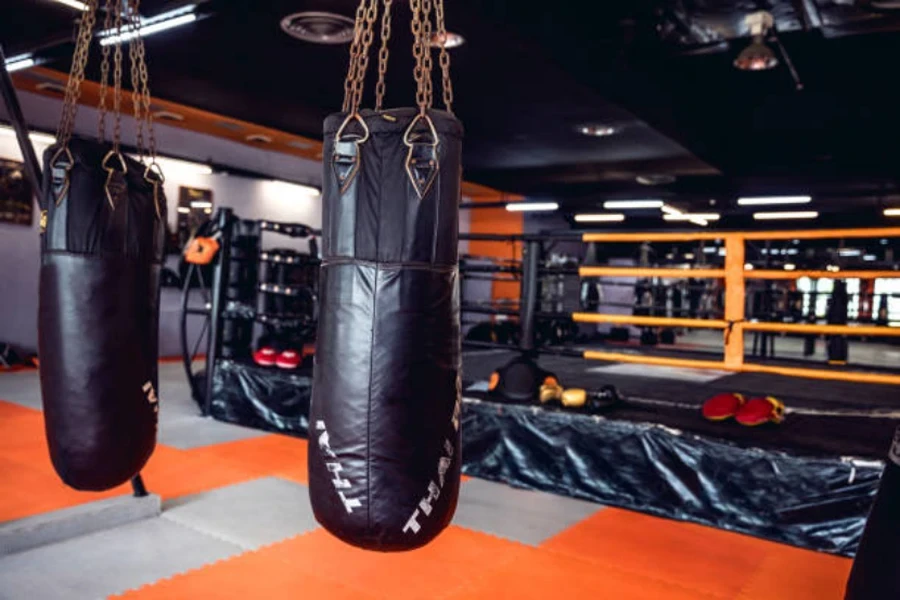
Specific training suitability:
Heavy Bags: The Outslayer is ideal for those focusing on power and technique due to its dense filling and durable construction. Combat Sports’ bag is particularly suited for Muay Thai practitioners with its long design accommodating low kicks and knee strikes.
Freestanding Bags: Century Wavemaster XXL’s stability and resilience make it suitable for intense kickboxing workouts. Everlast’s PowerCore, with its adjustable resistance, caters to a broad range of martial arts training, from karate to taekwondo.
Speed Bags: Cleto Reyes’s traditional design is perfect for boxers focusing on timing and rhythm, while Title Boxing’s Gyro Balanced model, with its consistent rebound, is excellent for users looking to enhance speed and reflexes.
In conclusion, each punching bag has distinct features catering to different needs. Whether it’s the durability of the Outslayer and Combat Sports heavy bags, the material quality of the Cleto Reyes and Title Boxing speed bags, the user-friendly designs of the Century Wavemaster XXL and Everlast PowerCore, or the specific training suitability of each model, users have a variety of options to choose from based on their individual requirements and preferences.
Conclusion
As 2024 unfolds, the punching bag market continues to offer a broad spectrum of choices, catering to diverse training needs with an emphasis on durability, material quality, and user experience. The meticulous analysis of heavy bags, freestanding bags, and speed bags reveals that each model presents unique features suited to specific training scenarios, ensuring a tailored fit for every user. For online retailers, staying attuned to these evolving preferences and the latest innovations in punching bags will be crucial in maintaining a competitive edge and meeting the dynamic demands of the fitness and combat sports industries.




